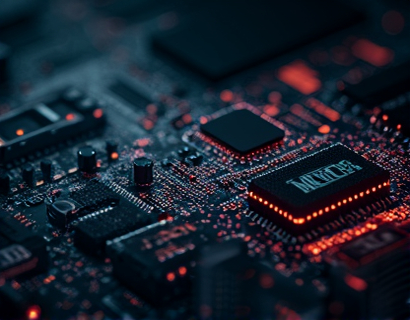Next-Gen Smart Contract AMMs: Revolutionizing DeFi Trading with Advanced Automation
The decentralized finance (DeFi) ecosystem has witnessed exponential growth, driven by innovative technologies and smart contract applications. Among these advancements, Automated Market Makers (AMMs) have emerged as a pivotal component, offering a decentralized alternative to traditional order books. Next-generation smart contract AMMs are pushing the boundaries of DeFi trading by integrating advanced automation, enhancing liquidity management, and streamlining trading strategies. This article delves into the transformative impact of these technologies, providing crypto experts and DeFi enthusiasts with insights into the future of decentralized trading.
Understanding Smart Contract AMMs
Traditional AMMs rely on algorithms to determine asset prices and manage liquidity pools, eliminating the need for order books and human intervention. Smart contract AMMs take this a step further by leveraging blockchain technology to create transparent, tamper-proof, and decentralized trading environments. These AMMs operate on platforms like Ethereum, Binance Smart Chain, and Solana, utilizing smart contracts to execute trades and manage liquidity.
At the core of smart contract AMMs are liquidity pools, which are collections of tokens locked in a smart contract. Users can deposit tokens into these pools and earn liquidity provider (LP) tokens as a reward. The price of assets in the pool is determined by the ratio of the two tokens, typically calculated using a formula like x * y = k, where x and y are the amounts of the two tokens, and k is a constant. This mechanism ensures that the market remains liquid and that trades can be executed without the need for a centralized exchange.
Advanced Automation in AMMs
The integration of advanced automation in smart contract AMMs represents a significant leap forward. Automation not only simplifies the trading process but also enhances efficiency and reduces the risk of human error. One of the key features of advanced automation is the implementation of algorithmic trading strategies directly within the smart contract. These strategies can be programmed to execute trades based on predefined conditions, such as price thresholds, volatility levels, and market trends.
For instance, a smart contract can be designed to automatically rebalance a portfolio when the price of a particular token deviates from a specified range. This ensures that the liquidity pool remains balanced and that liquidity providers benefit from optimal returns. Additionally, automation can facilitate complex trading strategies like arbitrage, where the smart contract identifies and exploits price discrepancies across different DeFi platforms.
Optimizing Liquidity Management
Liquidity management is a critical aspect of DeFi trading, and smart contract AMMs offer sophisticated tools to address this challenge. One of the primary benefits of smart contract AMMs is their ability to dynamically adjust liquidity based on market conditions. By using automated protocols, these AMMs can attract more liquidity during periods of high demand and redistribute it when needed, ensuring that the market remains fluid and responsive.
Another advanced feature is the implementation of yield farming mechanisms. Liquidity providers can earn passive income by depositing tokens into liquidity pools and participating in yield farming programs. These programs often offer higher returns compared to traditional savings accounts, incentivizing more users to contribute to the ecosystem. Smart contracts can automate the distribution of yields, ensuring that providers receive their rewards efficiently and transparently.
Enhancing Trading Strategies
Advanced automation in smart contract AMMs enables traders to implement sophisticated trading strategies with ease. One such strategy is the use of margin trading, where users can borrow assets to amplify their trades. Smart contracts can manage the borrowing and repayment process, setting margin requirements and executing automatic margin calls when necessary. This feature allows traders to capitalize on market movements while managing risk through automated controls.
Another advanced trading strategy is the implementation of stop-loss and take-profit orders. These orders can be programmed into smart contracts to automatically execute trades when certain price levels are reached. For example, a trader can set a stop-loss order to automatically sell a token if its price drops below a specific threshold, limiting potential losses. Similarly, a take-profit order can be set to lock in gains when the price reaches a predetermined level.
Improving Market Efficiency
The integration of advanced automation in smart contract AMMs significantly improves market efficiency. By eliminating the need for centralized order books and human intervention, these AMMs reduce transaction costs and increase trade execution speed. The transparency of blockchain technology ensures that all trades are recorded and verifiable, enhancing trust and security in the DeFi ecosystem.
Moreover, smart contract AMMs can facilitate cross-chain liquidity, allowing assets to be traded across different blockchain networks. This interoperability breaks down silos and creates a more connected DeFi landscape, where users can access a wider range of assets and trading opportunities. Automated protocols can manage the complexities of cross-chain transactions, ensuring seamless and secure exchanges.
Challenges and Considerations
While the benefits of next-generation smart contract AMMs are substantial, there are several challenges and considerations that need to be addressed. One of the primary concerns is the complexity of smart contracts, which can lead to vulnerabilities and potential exploits. Developers must prioritize security and conduct thorough audits to ensure the robustness of their contracts.
Another challenge is the regulatory landscape, which is still evolving in the DeFi space. Compliance with regulations is crucial to gain mainstream adoption and protect users' assets. Transparency and user education are also essential, as the technical nature of smart contract AMMs may pose barriers for less tech-savvy users.
Future Prospects
The future of DeFi trading is bright, with next-generation smart contract AMMs poised to drive further innovation. As blockchain technology continues to mature, we can expect more sophisticated automation features, enhanced user interfaces, and broader adoption across various financial applications. The integration of artificial intelligence and machine learning can further optimize trading strategies and liquidity management, making DeFi trading more intuitive and accessible.
Additionally, the development of layer 2 solutions and interoperability protocols will enhance the scalability and efficiency of smart contract AMMs. These advancements will not only improve the user experience but also attract more institutional investors, solidifying DeFi's position as a key player in the financial industry.
In conclusion, next-generation smart contract AMMs are revolutionizing DeFi trading by offering advanced automation, optimized liquidity management, and enhanced trading strategies. These technologies empower crypto experts and DeFi enthusiasts to navigate the dynamic crypto landscape with greater ease and confidence. As the ecosystem continues to evolve, the potential for innovation and growth remains vast, promising a future where decentralized trading is both efficient and accessible.











































